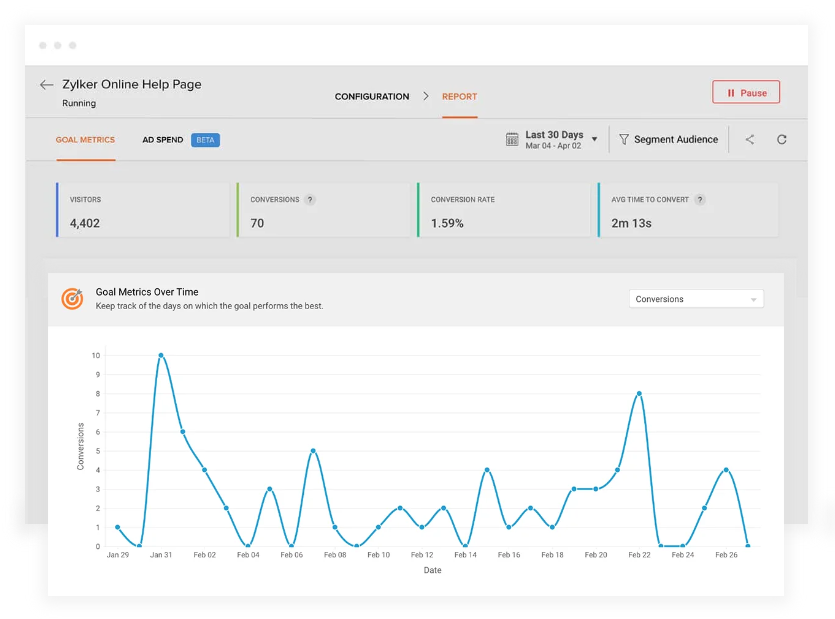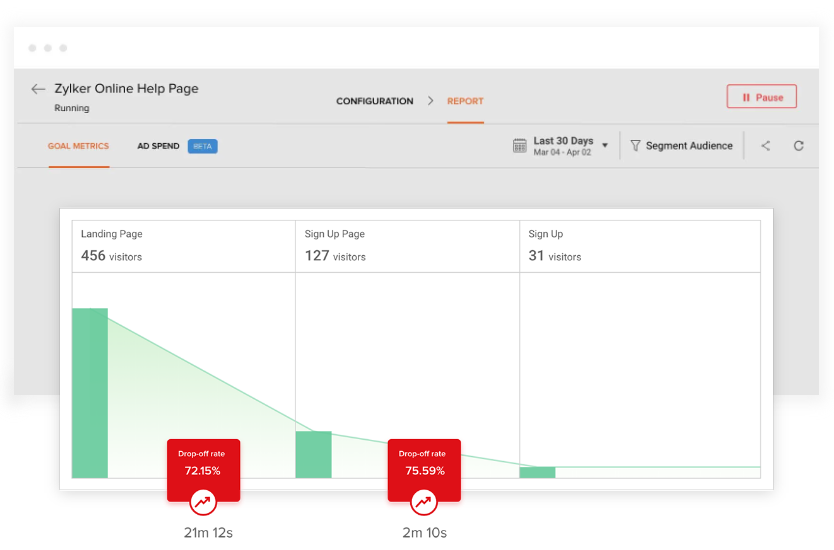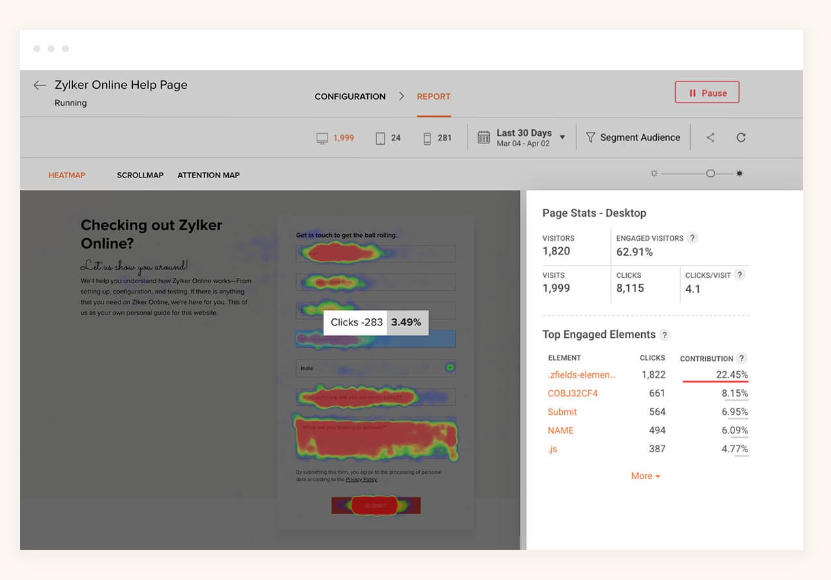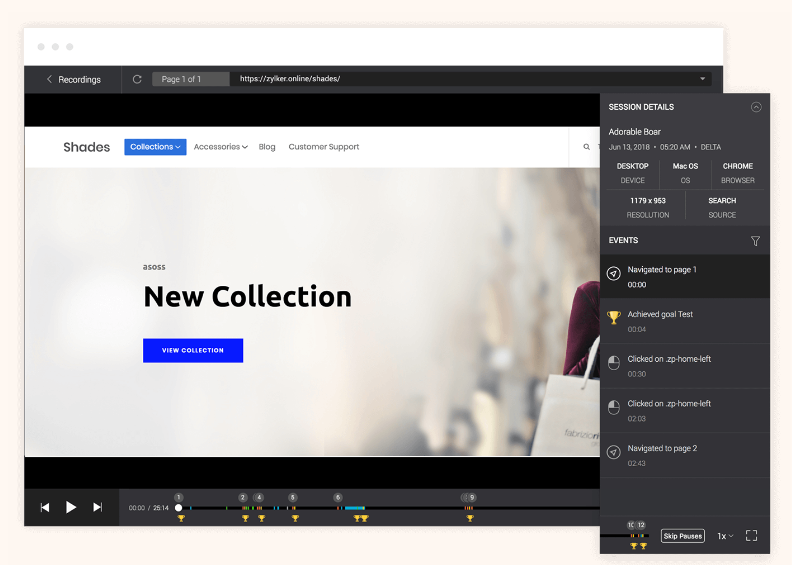Zoho Pagesense Overview

Zoho PageSense is a comprehensive tool designed to enhance website conversions by providing insights into visitor behavior. It enables businesses to make data-driven decisions to optimize their web pages effectively. PageSense tracks and analyzes user interactions, revealing what captures visitors’ interest and attention the most.
One of the standout features of PageSense is its ability to perform A/B testing. This allows you to create multiple versions of your website or specific pages, and then test these variations against each other to determine which one performs better in terms of user engagement and conversion rates. By comparing different layouts, designs, and content, you can identify the most effective elements that contribute to your website’s success.
Additionally, Zoho PageSense offers various tools to understand user behavior in-depth. Heatmaps, for instance, visually represent where visitors click, scroll, and spend the most time on your site. This information is crucial for identifying popular sections of your website and areas that might need improvement. Furthermore, session recording features let you watch real-time user interactions, providing a granular view of the user experience and helping to pinpoint any obstacles they encounter.
PageSense also supports goal tracking, allowing you to set specific objectives such as form submissions, purchases, or clicks on particular links. By monitoring these goals, you can measure the effectiveness of your optimization efforts and adjust strategies accordingly.
Overall, Zoho PageSense is a robust platform that combines analytics, A/B testing, and user behavior insights. It empowers businesses to create more engaging and effective websites by understanding what drives visitor actions and making informed adjustments. This leads to improved user experiences and higher conversion rates, ultimately boosting the overall performance of your website.
Establishing website objectives and evaluating their alignment with business goals involves tracking various elements on the website. This could include monitoring menu navigation, dropdown interactions, link and button clicks, as well as specific events like user sign-ups or purchases. By setting clear objectives and measuring these metrics, businesses can gauge the effectiveness of their website in driving desired outcomes and make informed decisions to optimize its performance.


Outline the visitor-to-customer journey by identifying the key pages that contribute to this progression. Analyze the flow of visitors from one step to the next, tracking the transition rates between each stage. Identify the pages where the highest drop-offs occur, pinpointing areas for improvement in the conversion funnel. This process allows for a comprehensive understanding of user behavior and enables optimization strategies to enhance the journey towards conversion.
Heatmaps provide valuable insights into how your website captures visitor attention. By visually representing user interactions, including clicks, scrolls, and cursor movements, heatmaps reveal which elements, such as images, content, or layout features, receive the most attention. Scrollmaps and attention maps offer further clarity by illustrating how users engage with different sections of a page and where important elements should be strategically placed for optimal visibility and impact. This data empowers website owners to make informed decisions about design and layout to improve user engagement and conversion rates.


Obtain video recordings of visitor interactions with your website to gain valuable insights into their browsing behavior. These recordings allow you to observe how users navigate your site, the actions they take on each page, and the sequence in which they move through different sections. By reviewing these recordings, you can identify patterns, preferences, and potential pain points in the user experience, enabling you to make informed optimizations to enhance usability and engagement.
Forms are crucial for lead generation and data collection. With form analytics, you can observe how visitors interact with your forms, identify fields they are hesitant to complete, and pinpoint the fields that cause them to abandon the form. By analyzing this data, you can optimize your forms to boost completion rates and increase the number of submissions.


Even minor changes to your website can significantly impact your business. With PageSense, you can avoid guessing which modifications will appeal to your visitors or enhance conversion rates. Instead, you can run an A/B test to determine the most effective changes based on real user preferences and behaviors.
Altering your website’s layout can significantly affect your success. To determine which layout yields the highest conversions, create separate URLs for each version and compare their performance. This approach helps identify the most effective design for achieving your business goals.


Customer behavior and preferences vary widely, so a one-size-fits-all approach isn’t effective. PageSense allows you to personalize each visitor’s website experience based on demographics, acquisition channels, past behavior, browsing patterns, and actions taken. This tailored approach ensures a more relevant and engaging experience for each user.
Use on-site and in-app polls to collect customer feedback. With PageSense’s polling tools, you can ask open-ended questions, conduct NPS surveys, and use Likert scale surveys. Analyze the responses to these polls to improve your website or product based on the feedback received.

Reach, engage, and re-engage your website visitors with pertinent information. You can send notifications to re-target visitors, share content they may find interesting, announce new features, and send transactional messages to opted-in users. This approach helps maintain and enhance visitor interaction with your website.


Create attractive and relevant pop-ups, slide-ins, and banners to engage your website visitors and convert them into customers. Select a template from our library, define your target audience, and set a trigger for your pop-ups. It’s that simple!
